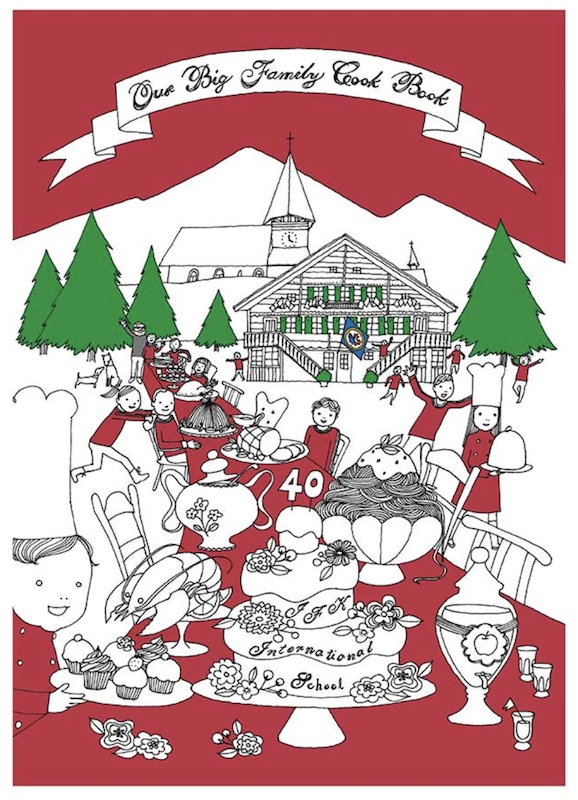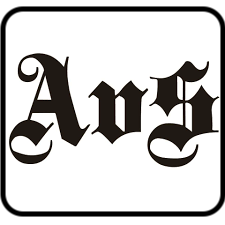People watching
08.12.2023 Profile, Rumour Has It, Cartoon, Arts & CultureAn Interview with Oliver Preston
Oliver Preston is a self-taught British cartoonist known for his drawings depicting the quirkiness of British town and country life – and skiing in Gstaad. Oliver spends as much ...
An Interview with Oliver Preston
Oliver Preston is a self-taught British cartoonist known for his drawings depicting the quirkiness of British town and country life – and skiing in Gstaad. Oliver spends as much time as he can in the Saanenland and caught up with GstaadLife to talk irony, fur coats and people watching.
How did you develop your unique style of humour and observation?
I’ve been drawing since a child. It’s a gift. I was always good at art and developed a love of cartoons through reading Asterix, Tintin and Thelwell books. I won art prizes at school and drew irreverent cartoons of teachers that I passed around the back of the class!
After graduating from university I spent ten years working in the City of London, but art remained a constant in my life. I accepted commissions to draw caricatures and was exhibited in Chelsea before I took the leap and decided to become a fulltime cartoonist.
My father had a great sense of humour so I grew up in a house full of laughter and my Swiss uncle set up a leading architectural practice. So the way I see it, the drawing comes from my Swiss side and the humour from England. If it was the other way around, I always say I wouldn’t have had a career!
What comes first in your creative process – the caption or the picture?
I think a cartoon is fifty percent drawing and fifty percent joke. Quite often if you look at the picture on its own it doesn’t mean anything, neither does the caption. But when you see the two together you get the full impact. Ideally the caption needs to be as short as possible. You want the reader to get the joke within about ten seconds or it hasn’t worked. The main challenge I face is thinking up ideas and have learned that my original idea is usually the right one. After drawing the picture I invariably fiddle with the caption, thinking I can improve it – only to go back to the idea I had in the first place. It’s almost this innate thing where you just need to trust yourself.
The amount of time it takes to complete a cartoon can vary enormously. Last year I was commissioned for a cartoon featuring 100 people in a drawing that measured two metres by a metre. That took me about a month. Against that a drawing for a magazine probably takes me a day or so – I might draw it in pencil one day, then ink and colour it in the next.
I draw in pencil first then scan it and send that as an early draft to the client so they can request changes before I ink it in. Details matter, especially for caricatures. The distance of the eyes to the nose and the nose to the mouth and the mouth to the chin all make a huge impact on whether the caricature looks like somebody or not. If it’s slightly wrong, even the tiniest change in the eyes or mouth will make all the difference.
It always amazes me how I start with a blank piece of paper, then I just start drawing and by the time I’m finished it’s a picture. It’s like where did that come from? It’s a beautiful thing. In the past I was more cautious and unsure of myself, but these days I launch straight onto the paper and get on with it.
What’s life like as a professional cartoonist?
I’m incredibly lucky to do something which I love. Art has been my hobby since I was a child. What’s not to like about colouring in?
I know what it’s like to work in the City in a high pressure environment. And while I still have to do things like paperwork which I don’t particularly enjoy, every time I pick up a pen or paintbrush I go into my own little world.
But I remember what it was like when I started out as a cartoonist. Money was pretty tight and you’re desperately trying to get published and there is a lot of rejection until you eventually succeed and get a slot. Then if you’re lucky you reach the stage where people start to recognise your work and they want more of it.
These days I get most of my work through word of mouth. It’s an absolute joy when somebody rings up from Norway or Germany, the USA or Portugal and they want me to draw a cartoon of their family celebrating a special moment. That means a lot.
Your work often depicts humorous social interactions and everyday life situations. How do you decide which moments to capture?
To be a cartoonist I think you need to be a good observer of life and of what’s going on around you. There are so many interesting characters here in the Saanenland – it’s as though they’re taken straight from a cast list of who you’d expect to see in Gstaad. It’s a very special place in terms of the interaction between all the different layers of society; how the local community handles the diversity of people who visit – whether farmers supping on their beer, young blades in the GreenGo or an 80-year-old enjoying lunch in the Grill with their extended family. It’s a real cross-section of life.
I am a people watcher and all human life is here. If I go out to dinner with my wife, I’ll be noticing all the people around me, how they’re speaking, their mannerisms, what they’re wearing, the banter. I’ll see people manoeuvering for tables, the regulars who feel at home and the newbies who have no idea what they’re doing. I take it all in and it reappears in future drawings.
How do you strike a balance between humour and satire when addressing social and cultural issues?
If it’s about freedom of speech, I believe we should be allowed a free rein. In the UK we have an amazing heritage in the genre of cartoons and caricature, of poking fun at our institutions, especially in political commentary. But we also know when to stop.
That said, I rarely draw political cartoons. Political cartoonists tend to be quite angry people which comes out in their drawings. I’m not an angry person; I’m more in the nature of the old Punch magazine – I like a good drawing, a good joke and to make people laugh. I always try to see the quirky and funny side of things and be sympathetic to the society I live in. This doesn’t mean I’m politically correct, nor am I particularly “woke”. In fact I don’t like woke; I like saying what I want to say. And with me what you see is what you get.
Your work often highlights British culture and society. Why do you think your cartoons resonate with a global audience?
While the people who enjoy my work come from all over the world and seem to have what I consider an international sense of humour, the key for me is that they get satire and irony. Irony is key because it’s a very British trait, and an important component of my cartoons.
It’s so nice when somebody gets my jokes … and then of course they always say: “You obviously know all the same people as me. All my friends are in your drawings!”
I am very lucky that many clients visit Gstaad. It’s an interesting place because it attracts a cacophony of visitors from all over the world. Perhaps they’ve stayed here or have a friend who lives here, perhaps they’ve seen a book featuring one of my skiing cartoons which reminded them of a visit. It’s a place that brings families together so that in itself makes it a special place.
How would you describe your connection to the Saanenland?
I first came to Gstaad in 1964 and spent winter holidays here with my Swiss cousins. We’d go skiing on the Wispile then ski back over the fields and climb over barbed wire fences to our chalet where my grandmother would cook a fantastic lunch of vegetable soup with local mountain cheese. I also remember walking through the village with her in the 1970s, seeing all the cars driving up and down the Promenade, men with an arm hanging out of the window, their beautiful girlfriends in the passenger seat.
And the fur coats! I get asked why I continue to draw women in furs but it’s really a throwback to my Bernese grandmother who always wore her fur coat and memories of all these fur coats walking up and down the Promenade. To this day that sets a kind of background as to what people expect because you get visitors arriving in fur coats, presuming that’s what everyone in Gstaad will be wearing.
So I’ve had a long relationship with the Saanenland and have seen many changes over the years. I was very sad when they removed the farmers’ bar in the Olden as I used to go there to play Yahtzee with friends and soak up the fantastic atmosphere. I think it’s a shame that’s gone, but that’s change for you and the atmosphere lives on in the Stübli bar at the Rössli. Still it’s not all bad. I think Gstaad has done incredibly well with its ability to rebuild structures in a very sympathetic way and think Saanen, our home, is unbelievably better and more beautiful than it was.
These days I come to Gstaad as often as possible – which basically means at the drop of a hat! I’m here regularly in the winter and summer and in between if I can manage it. There’s just something about the place. I defy anyone to drive up from Bulle or take the train from Montreux and not feel the weight lifted off their shoulders. There’s a frisson of excitement of driving through Montbovon and all the little villages, then as you get closer and wind up the hill to the Saanen valley it’s a sign of good times ahead. Of good friends, good company, good food, exercise, laughter, happy days, drinks and long lunches and – for me at least – lots of social observation. Lots and lots of ideas and a place where I like to draw.
You’ve just published your latest book. What’s the inspiration behind it?
This autumn I published a collection of my recent cartoons, which is always a fun project. It features many drawings on my favourite topics – British town and country life, shooting, tennis, drinking, that kind of thing – plus of course some Gstaad skiing cartoons. I am probably known more for my skiing and shooting cartoons than any other subjects. Skiing and the Palace Hotel are two of the things people expect to see in my work in the Saanenland. I have drawn many more cartoons featuring Gstaad that are not in the new book and which may appear in print at some point.
Just when I think I’ve done everything on Gstaad that there is to be done, I’ll be walking up the Promenade and do a double take. I’ll see something and think: that’s a cartoon! Like I said, I’m a people watcher.
ANNA CHARLES
FUN FACT:
At the JFK International School 40 anniversary, they published a "family" cookbook – guess what's Oliver's favourite recipe? The book can still be purchased from MüllerMedien in Gstaad if you want to try it out.

See more cartoons and books on the website - Oliver Preston Cartoons









